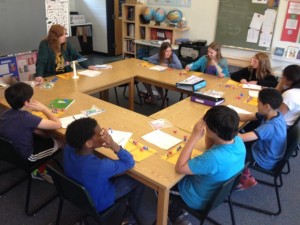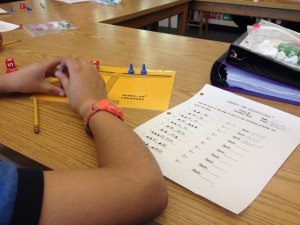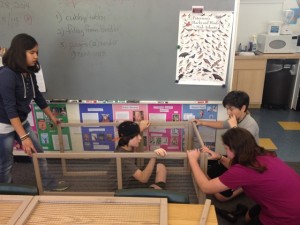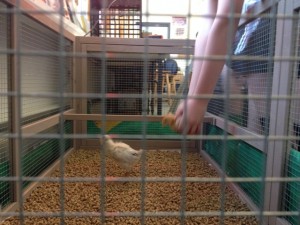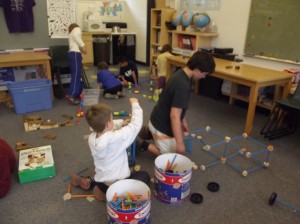In the midst of getting things ready for our camping trip, starting to write the many reports needed for the end of the year, working on speeches and yearbook material . . . well, a substantive blog entry just isn’t possible. But come back next week after we have had our camping trip and finished up some things that are part of our instructional plans.
Monthly Archives: May 2014
Week of May 18: All Sorts of Endings
As we roll into the last few weeks, we are wrapping up a lot of things. Many of our students are looking more willing to take on extra responsibility, to organize things without adult help, and find more ways to work together in mutually supportive ways.
- Teams of three did independent research projects to complete our social studies unit on Islam and West Africa (with a diversion into Muslim Spain) and are starting to share them with the group.
- We’re hearing a lot of good suggestions and praise as they share their speech drafts with each other, and many are now working on clear delivery of their finished speeches while committing them to memory.
- Personal Projects are in the final stage. Just about everyone is sounding pleased with the choice they made and what they have accomplished. Presentations will start next week.
- The Hands-on Algebra lessons have reached a range of ending points. We think we chose the right level of challenge and pace for everyone as we put our learning groups together. Two groups are still working, one has moved on to some data and statistical work that includes reviewing fraction and percentage skills, and the third is working again in the IMP textbook on a range of non-routine problems and puzzles.
- Our final hoagie sale went very smoothly — just one missed order, and we were able to fill it from extra stock. This is a very detail-loaded activity that requires attention and care. Hoagie money paid for our most recent trip to Henry Mercer’s amazing concrete house, and it will also pay for the expenses of our final camping trip.
- Thanks to the two pretzel sales, the group have raised $250 for their graduation gift to the school. Now all they have to do is decide on what it should be.
- We’ve set aside our collection of tales from the Arabian Nights and will be doing some Anansi the Spider stories as time permits.
- Music rehearsals for graduation are going well — this is really a group of singers.
We’ll be sending things home next week, primarily children’s collection of their written work in math, social studies, and language. We hope you’ll find time to go through it at some point and select some things to save in the family archive. The end is definitely near.
Week of May 12: The Spring Fair as a Learning Experience
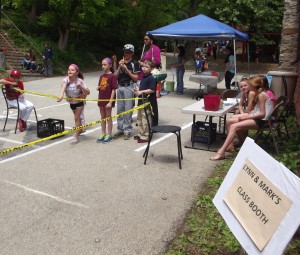 Every year at the start of May (just as we are trying to complete the last 2/3 of our teaching plans and hopes for the year), our spring fair comes along. We’ve just finished Miquon Grass selection and editing, need to do some final assessments, need to write and practice graduation speeches, and more. And then we need to devote some class time to organizing our booth for the fair. But after an initial sigh of resignation, we get into it and — as always — see how much learning goes on. Here are some examples:
Every year at the start of May (just as we are trying to complete the last 2/3 of our teaching plans and hopes for the year), our spring fair comes along. We’ve just finished Miquon Grass selection and editing, need to do some final assessments, need to write and practice graduation speeches, and more. And then we need to devote some class time to organizing our booth for the fair. But after an initial sigh of resignation, we get into it and — as always — see how much learning goes on. Here are some examples:
Social skills: Students need to communicate their booth ideas clearly, listen to the ideas of others, make a choice, and then perhaps spend their shift with classmates who are not their close friends. That last item means working out who is doing which specific job. When the fair is running, they may need to make some decisions about modifying the game either entirely or just for younger players. They need to offer encouragement to kids who have their hearts set on winning. And, finally, it means keeping to a commitment — to show up on time, focus on keeping the game going (instead of chatting with non-working friends who dropped by), and perhaps work longer than planned if their replacements are late. It’s all harder for kids this age than it might sound as described here.
Math: We always take this opportunity to integrate some math lessons — especially when we figure out how hard the game is and what it will take to win a prize ticket. We do many practice game sessions, finding the average (mean) scores as well as the mode and range, and then we need to figure out where the prize-winning score should be. This year, we brought in some of our first and second grade buddies to do a younger-kid sampling as well. Other math may depend on the game, but there is always more.
Graphic design: A good booth sign is legible, attractive, informative, and carefully planned. Do we need to draw guide lines for lettering? Can we resist over-decorating it so that it remains easy to read?
_____________________________
This year’s booth evolved gradually. I brought in some empty liter-size drink bottles (and a few others). Put it on a table? Set it up like bowling on the floor? How complicated should it be, especially in terms of scoring and strategy required? How can we make sure the bottle setup is consistent throughout the fair? (They numbered the spots on our table.) We needed to solve the problem of having kids walk through the throwning area as we saw it happening during the fair. It all went well. Every tme I checked in, I saw kids lined up to play and our workers busy at keeping things moving. Good job, folks!
Week of May 5: chicks and graduation traditions
In a very symbolic moment, our six little chicks have moved out of our protected classroom into the wider world of middle school . . . well, into the wider world of the outside pen. They took a while to find their way around the new territory, searching for their food and water with little success at first. But once one had found the locations, the others were quick to catch on. By the end of the day, they were all up on their roost and looking quite at home. Does this sound like what our 18 other chicks are about to do? We think it does.
We are well into working on graduation speeches in the classroom. Students are sharing memories with each other, trying out ideas, and conferring with us as they feel stuck or want to check out their progress. The challenge, really, is to make the speeches personal. We encourage them to tell us one detailed story — a day in Monkeyland when they first built a fort that really worked, the discovery of a favorite book that’s been read and re-read for years, the first time a pot really did rise on the wheel, one special game in the bamboo forest . . . We assure them that, after the audience has heard 18 unique speeches, they will all have a good sense of what it means to be a Miquon graduate.
The second part of speech writing is editing, getting them ready for publication in the yearbook — every word spelled correctly, finding a reasonable compromise between strict grammar and comfortable language, every sentence given the punctuation it requires. We do this in one-on-one conferences, just as we did the drafting of the content of the speech.
And the third part is working on delivery. Students are encouraged to learn their speeches by heart (in every sense). They also prepare a “rescue” copy that can be in large print, take up 2 pages in the onstage binder, and have selected things highlighted. If they go blank, the safety net is there. We work on emphasis, pacing, pronunciation, and eye contact with the audience. We spend time on microphone skills. Our students of any age don’t need a microphone in the Moore building — we can hear their voices at choice time all over the campus. They just need to learn to project when faced with an audience. But outdoors in a more formal setting, when the voices are not raised in a raucous game, a microphone is necessary. Where should you stand? How can you tell when you’re “on the mic” ? What happens if you rock back and forth or from side to side when you speak? We demonstrate how it can go wrong and work on making it go right. Is it stressful? For all of our kids, it is — to some degree. But it’s also empowering. As we explain, there are likely to be some times in their lives when they need to stand up and speak to a group — a celebration, a sales pitch, a political persuasion, a quest for social justice, a plea on behalf of themselves or someone else. They don’t need to love doing it (although many will) — they just need to know they can.
We did a lot of other things this week, but these two related rites of passage were the big ones.
Week of April 28: Personal projects, algebra, chicks, buddies, graduation stuff
All of our students should be launched on their personal projects now. I said to them on Friday that, as a group, they did some of the best and most helpful inquiries that we’ve ever seen. Many students reported that the preliminary research helped them focus their work, led them to refine their plan, and/or got them more excited about their choice. We’re looking forward to following their progress through their nightly project log.
We’re now well into working with the Hands-On Algebra program. After starting with half-groups to do the introductory work, we’ve now divided the class into four groups so we can individualize the pace and scope of the lessons. We hope your child is sharing some of what s/he is learning when s/he brings the materials home to do the homework.
Our chicks are growing rapidly, as many of our group have observed. Several of the group assembled a new, larger pen for them. We’ll probably take it and the chicks outside on a few warm days this coming week so they can scratch around in real dirt, enjoy some sunshine, and be seen by more of our whole community.
We got together for a “building afternoon” with our buddies in Elisa and Ted’s first/second group. Although we’ve had these materials in our room (or next door in Diane’s room) all year, most of our big kids didn’t show much interest in using them, even on days when the weather was bad. But they were SO absorbed in their own play on Friday afternoon that they didn’t interact much with their buddies at all! We’re curious now to see if they get out the Keva planks or marble race kits or anything else the next time we have a seriously rainy day.
And it’s May, which means that the Graduation Juggernaut gathers momentum. Parents have been asked to send in skit ideas. We’ve made our group decision about the colors and typeface for the graduates’ t-shirts, and parents will be getting the order form from Connie very soon. This coming week, we’ll start working on speeches. The end is definitely near.

